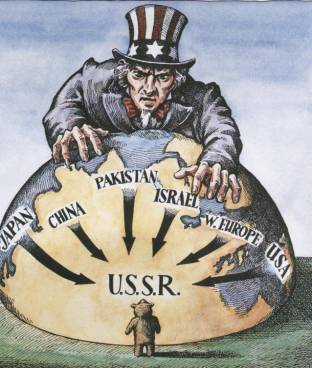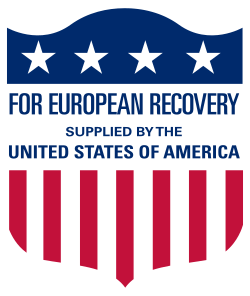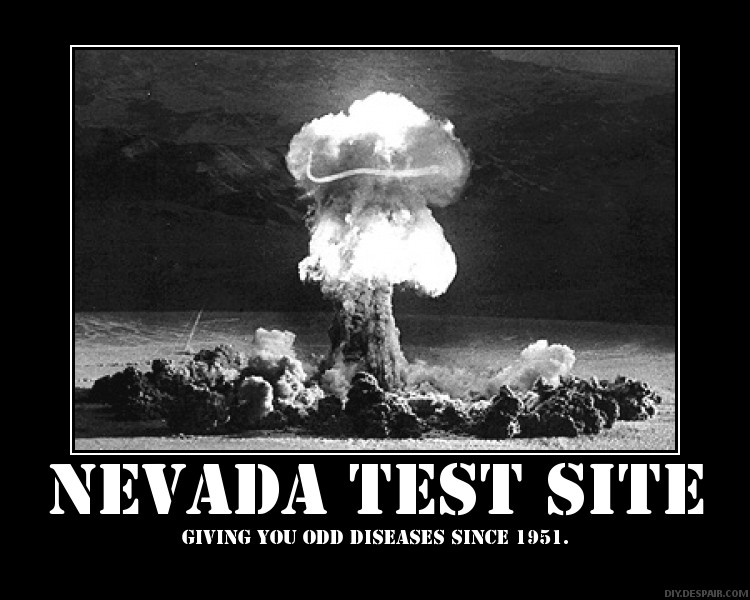Kennedy DBQ
Click on the link above to access the Kennedy DBQ. Do pages 8 thru 24 as homework for this week. This will go in your Binder and I hear will be a graded item. Please work on this quitly at your desk at the conclusion of your test.
GO MUSTANGS
Monday, March 31, 2014
Nuclear Tests in 1950s - Jessica Poldrugo
In the 1950s, the arms race for nuclear weapons was intensifying. The United States had already used several bombs on such places such as Hiroshima and Nagasaki and the USSR was close behind in their development. The U.S. had officially set up their test site on the Nevada Test Site. They were also using the Marshall Islands as another test site.
The Nevada Test Site is located 65 miles from Las Vegas. It was established on January 11, 1951 and measures about 1,350 square miles. The first test at this site was on January 27, 1951. The mushroom clouds could be seen from Las Vegas, which proved to be a big tourist attraction.
On January 31, 1950, Truman declared the United States Atomic Energy Commission would begin constructing a hydrogen bomb.
The first Soviet breakthrough did not come until 1953.
The first British atomic bomb detonated on October 3, 1952.
Rachel Weaver: Containment
Containment was a policy to prevent the spread of communism. For the Cold War this was a policy response to the Soviet Union. Containment was also apart of the Truman Doctrine, and was a big part of President Truman policies. Containment help win the Cold War. The goal was to contain the communists without a nuclear war.


Containment was a policy to prevent the spread of communism. For the Cold War this was a policy response to the Soviet Union. Containment was also apart of the Truman Doctrine, and was a big part of President Truman policies. Containment help win the Cold War. The goal was to contain the communists without a nuclear war.

The Truman Doctrine- Jared Tanner
The Truman
Doctrine was an
international relations policy set forth by the U.S. President Harry Truman. It stated that the U.S. would
support Greece and Turkey with economic and military aid to prevent them
from falling into soviet control. Many consider this doctrine to be the start
of the cold war and the policy of containment.
Tuesday, March 25, 2014
The GI Bill by kassandra nava
- The Servicemen’s Readjustment Act of 1944,commonly known as the GI Bill of Rights was to help civilians into normal life.
- Some people shunned the idea of paying unemployed veterans 20$ a week because that made them loose their incentive to work, while other questioned sending battle hardened veterans to colleges and universities, which was a privilege reserved for the rich.
- Much of the urgency stemmed from a desire to avoid the missteps following World War I, when discharged Veterans got little more than a $60 allowance and a train ticket home.
- During the Great Depression, some Veterans found it difficult to make a living. Congress tried to intervene by passing the World War Adjusted Act of 1924, commonly known as the Bonus Act. The law provided a bonus based on the number of days served. But there was a catch: most Veterans wouldn't see a dime for 20 years.
- The return of millions of Veterans from World War II gave Congress a chance at redemption. But the GI Bill had far greater implications. It was seen as a genuine attempt to thwart a looming social and economic crisis. Some saw inaction as an invitation to another depression.
- Ultimately, Rep. John Gibson of Georgia was rushed in to cast the tie-breaking vote. The Senate approved the final form of the bill on June 12, and the House followed on June 13. President Franklin D. Roosevelt signed it into law on June 22, 1944.
- The Veterans Administration, was responsible for carrying out the law’s key provisions: education and training, loan guaranty for homes, farms or businesses, and unemployment pay.
- Before the war, college and home ownership were, for the most part, unreachable dreams for the average American. Thanks to the GI Bill, millions who would have flooded the job market instead opted for education. In the peak year of 1947, Veterans accounted for 49 percent of college admissions. By the time the original GI Bill ended on July 25, 1956, 7.8 million of 16 million World War II Veterans had participated in an education or training program.
- In 2008, the GI Bill was updated once again. The new law gives Veterans with active duty service on, or after, Sept. 11 2001, enhanced educational benefits that cover more educational expenses, provide a living allowance, money for books and the ability to transfer unused educational benefits to spouses or children.
-
President Franklin D. Roosevelt signs the G.I. Bill into law.

Sunday, March 23, 2014
The Iron Curtain
The Iron Curtain
--Hannah Aquino
After WWII, the Soviet Union created the iron curtain as a political and military barrier that isolated it from the rest of the world. The term "iron curtain" was coined by Winston Churchill in his "Sinews of Peace" speech in 1945. The blockade separated eastern Europe (including East Germany, Czechoslovakia, Poland, Hungary, Romania, Bulgaria, and the Soviet Union) from western Europe and all of its allies, or any non-communist countries. Any and all countries east of the curtain was strong influenced by the communist Soviet Union. This fence stretched for thousands of kilometers, even past the Berlin Wall. The Iron Curtain fell in the late 1980s, which also symbolized the end of WWII.
The Warsaw Pact-Madeline Allman
- It was also known as the Warsaw Treaty Organization.
- The Warsaw Pact was a military alliance of communist nations in eastern Europe. They pledged mutual defense and military aid.
- It included Albania, Bulgaria,Czechoslovakia,east Germany,Hungary,Poland,Romania,and the Soviet Union.
- It was established in retaliation to NATO, a similar union between non-communist nations.
- It was signed in May, 1955.
Cold War and 1950's Magazine
California State Standards Addressed:
http://www.cde.ca.gov/be/st/ss/documents/histsocscistnd.pdf
11.9 Students analyze U.S. foreign policy since World War II.
1. Discuss the establishment of the United Nations and International Declaration of
Human Rights, International Monetary Fund, World Bank, and General Agreement
on Tariffs and Trade (GATT) and their importance in shaping modern Europe and
maintaining peace and international order.
California Department of Education Reposted June 23, 200952 GRADE ELEVEN
2. Understand the role of military alliances, including NATO and SEATO, in deterring
communist aggression and maintaining security during the Cold War.
3. Trace the origins and geopolitical consequences (foreign and domestic) of the Cold
War and containment policy, including the following:
• The era of McCarthyism, instances of domestic Communism (e.g., Alger Hiss) and
blacklisting
• The Truman Doctrine
• The Berlin Blockade
• The Korean War
• The Bay of Pigs invasion and the Cuban Missile Crisis
• Atomic testing in the American West, the “mutual assured destruction” doctrine,
and disarmament policies
DUE Monday at the beginning of class Monday March 24th
25 points
Students will make a magazine on 1950's America.
You will get into groups of 4
The magazine must include the following;
2 World News Events
2 domestic Events
3 ads from the 1950's
1 sports event
1 economic event
3 obituary's
You mus have a picture, either drawn or printed for each article
Use the Study Guide List for ideas
Students will also be assigned one topic from the list below and contribute to this blog for the class study review. A picture must be included in the review.
http://www.cde.ca.gov/be/st/ss/documents/histsocscistnd.pdf
11.9 Students analyze U.S. foreign policy since World War II.
1. Discuss the establishment of the United Nations and International Declaration of
Human Rights, International Monetary Fund, World Bank, and General Agreement
on Tariffs and Trade (GATT) and their importance in shaping modern Europe and
maintaining peace and international order.
California Department of Education Reposted June 23, 200952 GRADE ELEVEN
2. Understand the role of military alliances, including NATO and SEATO, in deterring
communist aggression and maintaining security during the Cold War.
3. Trace the origins and geopolitical consequences (foreign and domestic) of the Cold
War and containment policy, including the following:
• The era of McCarthyism, instances of domestic Communism (e.g., Alger Hiss) and
blacklisting
• The Truman Doctrine
• The Berlin Blockade
• The Korean War
• The Bay of Pigs invasion and the Cuban Missile Crisis
• Atomic testing in the American West, the “mutual assured destruction” doctrine,
and disarmament policies
DUE Monday at the beginning of class Monday March 24th
25 points
Students will make a magazine on 1950's America.
You will get into groups of 4
The magazine must include the following;
2 World News Events
2 domestic Events
3 ads from the 1950's
1 sports event
1 economic event
3 obituary's
You mus have a picture, either drawn or printed for each article
Use the Study Guide List for ideas
Students will also be assigned one topic from the list below and contribute to this blog for the class study review. A picture must be included in the review.
Task Review:
1. Create 1950's Magazine in groups
2. Upload study guide item onto trabucohistory.com
3. Study for Test, Monday March 31
The Marshall Plan
Kyle Sowatsky
The Marshall Plan was the American initiative to aid Europe, in which the United States gave money to reconstruct European establishments after World War II in order to combat the spread of Soviet communism. The operation lasted for about four years. The goals of the United Stats were to rebuild war-devastated regions, remove trade blockades and barriers, modernize industry, and create a newly prosperous Europe. Because of the Marshall Plan, many European countries favored the United States over the Soviet Union. The Marshall Plan clearly stated the obstacles for post war recovery, which in turn caused many look toward the future and helped uncover ways to prevent a third world war. In the beginning of the operation, recovery was slow but become quickened in pace as time went on.

Saturday, March 22, 2014
Eisenhower Elected President By Jorge Moreno
Eisenhower was a five star general before he became president who planned and supervised the invasion of North Africa and also was successful in the invasion of France and Germany from the western front. He also became the first supreme commander of NATO. After World War II, Eisenhower served as army chief of staff under President Harry S. Truman. Eisenhower entered the 1952 presidential race as a Republican against Adlai Stevenson. He beat Stevenson in a landslide ending two decades of Democratic presidents. During his first year at presidency he used nuclear threats to end the Korean war with China. He authorized the Interstate Highway System to make traveling easier and in case of attack it couldl be an evacuation route and created NASA which created a race between Russia and America in who wa capable to land a man on the moon first. President Eisenhower signed the first Civil Rights legislation in 1960 which allowed African Americans to vote. Dwight Eisenhower died in Washington, D.C. on March 28, 1969 at the age of 78 having endured multiple heart attacks.

Friday, March 21, 2014
Bay of Pigs By Ryan Carcano
*The bay of pigs was from April 17-19 1961
*Was a failed invasion of Cuba undertaken by the CIA-sponsored paramilitary group Brigade 2506 on April 17
*A counterrevolutionary military trained and funded by the United States government's CIA
*Launched from Guatemala the invading force was defeated within three days by the Cuban armed forces by Castro
*On April 15 eight CIA-supplied B-26 bombers attacked Cuban air fields and returned to the US
*On the night of April 16, the main invasion landed at a beach called Playa Giron in the Bay of Pigs
*The bay of pigs was from April 17-19 1961
*Was a failed invasion of Cuba undertaken by the CIA-sponsored paramilitary group Brigade 2506 on April 17
*A counterrevolutionary military trained and funded by the United States government's CIA
*Launched from Guatemala the invading force was defeated within three days by the Cuban armed forces by Castro
*On April 15 eight CIA-supplied B-26 bombers attacked Cuban air fields and returned to the US
*On the night of April 16, the main invasion landed at a beach called Playa Giron in the Bay of Pigs
Alger Hiss
Megan Logsdon
- US State Department official
- accused of spying for the Soviet Union and was imprisoned for two years
- denied any involvement in espionage
- born in Baltimore
- attended Harvard
- worked in the Roosevelt administration
- served as Secretary General at the 1945 San Francisco meeting at which the UN was founded
- was told he was a communist
Nikita Khrushchev - Francisco Rosales
Nikita Khrushchev was the First Secretary of the Communist Party of the Soviet Union. He was in office from March 14, 1953-October 14, 1964. He was a politician who led the Soviet Union during part of the Cold War. He also was the Chairman of the Council of Ministers, or Premier, from 1958 to 1964. Khrushchev was responsible for the partial de-Stalinization of the Soviet Union, for backing the progress of the early Soviet space program, and for several relatively liberal reforms in areas of domestic policy. Khrushchev's party colleagues removed him from power in 1964, replacing him with Leonid Brezhnev as First Secretary and Alexei Kosygin as Premier.


Taft-Hartley Act by Aly Piedad

- The Taft- Hartley Act was also known as the Labor Management relations act.
- It demobilized the labor movement, by imposing limits on labor ability to strike and prohibit radical leaders from power.
- It monitored the activities and power of labor unions.
- The Taft-Hartley Act prohibited strikes
- Due to this act, small unions were badly affected, but the labor movement was negatively affected as a whole.
WebRep
currentVote
noRating
noWeight
Truman vs Dewey - Naoki Atkins

Truman holding the famous issue of the Chicago Tribune
-Greatest election upset in American history. People predicted that Truman would be defeated by Dewey
-"Dewey Defeats Truman" was a famously incorrect banner headline on the front page of the Chicago Tribune
-Early polls showed that Thomas Dewey had an insurmountable lead. Thus he decided to run on a conservative campaign
-With nothing to lose, Truman went on the attack and covered 30,000 miles by rail and delivered his blistering campaign message to 6 million people
-promised labor that he would fight for the repeal of Taft-Harley
-reached out to northern black voters by supporting strong civil rights legislation
-pledged to farmers that he would back increased price supports
Thursday, March 20, 2014
Truman Fires Macarthur
Truman Fires Macarthur- Ryan Grace
- General Macarthur and Truman start to disagree on things
- Which in turn causes tension between the two
- Macarthur wanted to bomb certain parts of China, which wasn't smart
- 1951- Macarthur's replacee Matthew Ridgeway steps in
- Macarthur's firing didn't bode well with his fellow americans
HUAC by Erin Klimisch
The House Un-American Activities Committee (HUAC) was an investigative committee of the United States House of representatives. It was created in 1938 to investigate alleged disloyalty and substance activities on the part of private citizens, public employees, and those organizations suspected of having communist ties. In 1969, the House changed the committee's name to "House Committee on Internal Security". They monitored society for anything it considered unpatriotic. It was supposed to protect America from subversion. In practice, it conducted ill-conceived witch-hunts and accomplished nothing useful.
Levittown- By Jolie Nelson
Levittown is the model on which scores of post world war II suburban communities were based. It started out as an experiment in low-cost, mass produced housing. It practically became the most famous suburban development in the world.
It was built by William Levitt and his family. They offered affordable housing to returning GIs and their families in the form of small, detached, single-family houses.Levitt combined the idealized middle-class life of the prewar suburban communities with the democratized life of younger, mainly urban-raised GIs and their families.


It was built by William Levitt and his family. They offered affordable housing to returning GIs and their families in the form of small, detached, single-family houses.Levitt combined the idealized middle-class life of the prewar suburban communities with the democratized life of younger, mainly urban-raised GIs and their families.
Subscribe to:
Posts (Atom)








